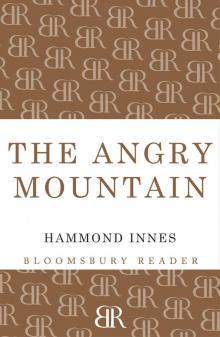- Home
- Hammond Innes
The White South
The White South Read online
Contents
Cover
About the Book
About the Author
Also by Hammond Innes
Title Page
DISASTER IN THE ANTARCTIC
Chapter I
Chapter II
Chapter III
Chapter IV
Chapter V
Chapter VI
Chapter VII
Chapter VIII
Chapter IX
Chapter X
THE SURVIVORS
Copyright
About the Book
A 22,000 ton whaling ship steams into a broken plain of white, glimmering ice during the howling fury of an Antarctic gale. What madness drives the ship forwards, deeper and deeper into the ice until its jagged edges hold her fast? Marooned amidst the pitiless, frozen wastes, the crew of the Southern Cross make a desperate attempt to survive against the odds.
About the Author
Ralph Hammond Innes was born in Horsham, Sussex, on 15 July 1913 and educated at Cranbrook School, Kent. He left school aged eighteen, and worked successively in publishing, teaching and journalism. In 1936, in need of money in order to marry, he wrote a supernatural thriller, The Doppelganger, which was published in 1937 as part of a two-year, four book deal. In 1939 Innes moved to a different publisher, and began to write compulsively, continuing to publish throughout his service in the Royal Artillery during the Second World War.
Innes travelled widely to research his novels and always wrote from personal experience – his 1940s novels The Blue Ice and The White South were informed by time spent working on a whaling ship in the Antarctic, while The Lonely Skier came out of a post-war skiing course in the Dolomites. He was a keen and accomplished sailor, which passion inspired his 1956 bestseller The Wreck of the Mary Deare. The equally successful 1959 film adaptation of this novel enabled Innes to buy a large yacht, the Mary Deare, in which he sailed around the world for the next fifteen years, accompanied by his wife and fellow author Dorothy Lang.
Innes wrote over thirty novels, as well as several works of non-fiction and travel journalism. His thrilling stories of spies, counterfeiters, black markets and shipwreck earned him both literary acclaim and an international following, and in 1978 he was awarded a CBE. Hammond Innes died at his home in Suffolk on 10th June 1998.
OTHER NOVELS BY HAMMOND INNES
Air Bridge
Attack Alarm
Atlantic Fury
Campbell’s Kingdom
Dead and Alive
Delta Connection
Golden Soak
High Stand
Isvik
Killer Mine
Levkas Man
Maddon’s Rock
Medusa
North Star
Solomons Seal
Target Antarctica
The Angry Mountain
The Big Footprints
The Black Tide
The Blue Ice
The Doomed Oasis
The Land God Gave to Cain
The Last Voyage
The Lonely Skier
The Strange Land
The Strode Venturer
The Trojan Horse
The Wreck of the Mary Deare
Wreckers Must Breathe
HAMMOND INNES
The White South
Disaster in the Antarctic
DAWN WAS BREAKING as the first news of the disaster reached London. It was February 10th and the rattle of milk bottles was the only sound in the black, frost-bound streets. Up in the City, Covent Garden and Billingsgate were halfway through the day’s work and the pubs were open. In nearby Fleet Street a Reuter’s operator was handed a news flash and his fingers ran automatically over the keys of his machine as he transmitted the message to subscribers. Two blocks away, in the office of a big London daily, a sleepy sub-editor heard the clack of the message as it came through on the teleprinter. He watched it as the carriage of the machine jerked back and forth. Then the yellow tongue of paper was thrust through the slit in the glass top. He tore it off and stood there reading it:
CAPETOWN FEB 10 REUTER: SOS RECEIVED FROM FACTORY SHIP SOUTHERN CROSS. SHIP IS CAUGHT IN ICE IN WEDDELL SEA AND IN DANGER OF BEING CRUSHED. NORWEGIAN FACTORY SHIP HAAKON 400 MILES FROM POSITION OF SOUTHERN CROSS GOING TO RESCUE.
REUTER 0713
The sub-editor yawned, tossed the sheet of paper into the news basket and returned to the work of subbing a feature page article. In a big office block in Fenchurch Street, the telephone rang incessantly on the third floor. These were the offices of the South Antarctic Whaling Company and only the cleaners were there. The telephone went unanswered. In Whitehall, at the Admiralty, a messenger hurried along the empty, echoing corridors. He handed a message to the duty officer. The duty officer rubbed the sleep out of his eyes, read the message through, placed it in a basket marked “for immediate attention” and enquired about tea. High up above Queen Victoria Street an operator at one of the switchboards in Faraday Buildings noted the urgency of an incoming call from Capetown and searched the telephone directory. Then she switched the call from the offices of the South Antarctic Whaling Company to the flat of Albert Jenssen in South Kensington.
Albert Jenssen was still in bed. The telephone woke him and he was half asleep as he groped for the receiver and lifted it to his ear. A moment later and he was sitting up in bed, wide awake and speaking rapidly into the phone. When he had finished, he replaced the receiver automatically and sat there for a moment, regardless of the cold air that blew in through the open windows, a dazed expression on his face. Then he fell upon the telephone and call after call went out from the flat in South Kensington : cables to Durban, the Falkland Islands and the whaling stations of South Georgia ; calls to Sandefjord and Tönsberg in Norway, to Leith in Scotland, to the BBC, to a Cabinet Minister and finally to the Admiralty. The duty officer at the Admiralty was forced to abandon his second cup of tea and interrupt an admiral in the midst of shaving.
And by eight o’clock messages were pouring over the ether: Admiralty to C-in-C. American West Indies; Admiralty to H.M. Sloop Walrus, at Port Stanley in the Falklands; Director South African Naval Forces, Capetown, to Admiralty, London; British Broadcasting Corporation to Australian Broadcasting Commission. And as the official messages increased in a desperate effort to avert disaster, the news agencies joined in and the tempo grew—Reuter’s Correspondent, Capetown, to Reuter’s, London; U.P. to New York; Tass to Moscow; Havas to—
By midday more than 150 million people knew that a ship of 22,000 tons belonging to a British whaling company was locked in the grip of the Antarctic ice and was being slowly crushed. As they sat at their desks or worked in their factories they were secretly thrilled at the thought of over 400 men face to face with death in the pitiless, frozen wastes of the Antarctic.
The Admiralty ordered the sloop, Walrus, to proceed to South Georgia, refuel and then make an attempt to reach the Southern Cross. A South African naval corvette was despatched from Capetown, also with orders to refuel at South Georgia. The Board of Trade diverted a tanker, unloading in Durban, to South Georgia to fuel search vessels. Det Norske Hvalselskab of Sandefjord, Norway, announced that their factory ship, Haakon, which had steered for the Southern Cross within half an hour of receiving the first S O S at 03.18 hours, was now within 200 miles of the ship’s last position. The United States government offered the services of the aircraft carrier Ohio then cruising off the River Plate.
Meanwhile events moved fast in the Antarctic. An early report that the Southern Cross had dynamited an area of clear water and was being warped round, was followed by the news that the way out of the ice was blocked by several icebergs which were charging into the pack. The tanker, Josephine, and the refrigerator
ship, South, were standing by on the edge of the pack, together with the rest of the South Antarctic Company’s fleet, unable to do anything. By midday the whole of the starboard side of the Southern Cross was buckling under pressure of the ice, and at 14.17 hours Captain Eide, the master, gave the order to abandon ship. In a final message before unloading the radio equipment on to the ice, Eide warned the Haakon not to enter the ice beyond the line of icebergs. That was the last message received from the Southern Cross.
All that night the lights blazed in the South Antarctic Whaling Company’s offices in Fenchurch Street. But no message came through from the survivors. Utter silence had closed down on the abandoned ship and it was clear that this was the worst sea disaster in peacetime since the Titanic went down in 1912.
The most detailed picture of the events leading up to the disaster available on the morning of the 11th was contained in a feature article in London’s largest daily. The writer’s main sources of information were Jenssen, London manager of the South Antarctic Whaling Company, the company’s agent in Capetown, the Admiralty, Det Norske Hvalselskab and the files of his office library. The article gave the full story of the South Antarctic Company’s whaling expedition. It was headed—DISASTER IN THE ANTARCTIC—and read :
“The Southern Cross left the Clyde on 16th October last with a total of 411 men and boys. In charge of the expedition was Bernt Nordahl, factory manager. Hans Eide was master and as assistant manager was Erik Bland, son of the chairman of the South Antarctic Whaling Company. About 78 per cent of those on board were Norwegians, mainly from Sandefjord and Tönsberg. The rest were British. With her sailed an ex-Admiralty corvette, converted to act as a whale-towing vessel, and the refrigerator ship, South.
“The Southern Cross arrived at Capetown on 14th November where her catchers and a tanker were waiting for her. The expedition sailed on 23rd November. The fleet then consisted of the factory ship, a vessel of 22,160 tons, 10 whale catchers, each of under 300 tons, two buoy boats (catchers used for towing), three ex-naval corvettes for towing whale, one refrigerator ship, one tanker, and an old whaler to transfer the meat to the refrigerator ship. One of the towing vessels was later sent back to Capetown to pick up electric harpoon equipment. The company intended to experiment during the season with the electrocution of whales, a method of killing that was in its infancy prior to the war.
“The whaling season in the Antarctic is of four months’ duration—December, January, February, March. These are the summer months and whaling expeditions are limited to a certain period by international agreement in an attempt to preserve the whale and allow uninterrupted breeding. Unrestricted killing during the last century in the Arctic resulted in the complete extermination of whale in the Northern Hemisphere for many years. The present season for fin whale opened on 9th December. But prior to that, operations are permitted against the sperm whale. Most expeditions avail themselves of this in order to test equipment. This season, apart from the South Antarctic Company’s expedition, there were eighteen others—ten Norwegian, four British, one Dutch, one Russian and two Japanese.
“On 29th November the Southern Cross sighted South Georgia and was in radio-telephone communication with the shore-based whaling stations on this island. They reported unprecedentedly bad conditions. Temperatures were much lower than normal with pack ice still piled against the western and southern shores of the island. Their catchers, operating in a 200-mile radius, spoke of heavy drift ice with bergs much more frequent and much bigger than usual. On 2nd December the Southern Cross commenced operations, her catchers killing 36 sperm whale in seven days, despite low temperatures and severe gales. On 9th December she began full-scale operations. She was then about 200 miles west of South Thule, the most southerly of the Sandwich Group, and steaming south-west. Reports of both Nordahl, the factory manager, and Captain Eide, the master, to the London office all spoke of violent and incessant gales, low temperatures, loose pack ice and an unusually large number of gigantic icebergs.
“Whale seemed very scarce by comparison with the previous bumper season and on Boxing Day Nordahl reported trouble with the men. This is almost unheard of in Norwegian or British whaling fleets where the men have a financial interest in the catch. But when Jenssen was pressed for fuller details he said he had no statement to make on the matter.
“The matter must have been serious, however, for Colonel Bland, chairman of the company, left London Airport on 2nd of January for Capetown in a privately chartered plane. He undertook the journey against the advice of his doctors. He had been seriously ill for some time with heart trouble. With him went his daughter-in-law, a German technical adviser on the electrical harpoon and Aldo Bonomi, the well-known photographer. His daughter-in-law, Mrs. Judie Bland, is the daughter of Bernt Nordahl. On 3rd January news was received at the London office that Nordahl, the leader of the expedition, had disappeared the previous night, presumed lost overboard.
“Colonel Bland arrived at Capetown early on the 6th and left the same night, together with Nordahl’s daughter, in the towing boat which had been dispatched to collect the new harpoon equipment. On reaching the Southern Cross on the 17th Colonel Bland assumed control of the expedition. Only 127 whale had been caught at that time against a previous season’s total of 214. In a week of bad gales the ten catchers had only brought in 6 whale. Bland sent his catchers out in a wide search. They found heavy pack ice to the south and south-east and one of the catchers had difficulty in extricating itself from the ice. All catchers reported few whale. Meanwhile radio contact had been established with the Haakon, 600 miles to the south-west. The Norwegian ship reported whale in plenty. Colonel Bland decided on the 18th to steam south. A great deal of loose pack was encountered, but on the 23rd the vessels were in open sea in Lat. 66.01 S., Long. 35.62 W. with an abundance of whale.
“Operations from the 23rd January to 5th February produced 167 whale. On the 6th and 7th there was a bad storm and on the night of the 7th one of the catchers, which had run into the ice for shelter, damaged its rudder on a floe. When the wind had died down a catcher and a corvette were sent to its assistance. But in the early hours of the 8th these two vessels were in collision in the ice, one of them being sunk and the other set on fire. The mishap occurred about 120 miles south-east of the Southern Cross and within sight of the catcher they had come to rescue. Both crews were reported safe on the ice with the loss of two men.
“Another corvette was sent to the assistance of the three vessels. Meanwhile, the Southern Cross, which had already refuelled from the tanker, completed the transfer of whale oil to this ship. On the night of the 8th the corvette reported that heavy pack ice was preventing her from approaching nearer than 20 miles to the damaged catchers. No further news had been received from these vessels.
“The wind had risen again to gale force. But despite this the Southern Cross herself went to the assistance of the catchers. At 6.30 p.m. on the 9th she sighted the corvette, which had run into loose pack in order to shelter from the heavy seas. The whole fleet was then together with the exception of the three missing catchers, for owing to the bad conditions no catchers had been sent out after whale. A conference was held on the Southern Cross and it was decided to steam into the pack ice, following leads which ran east and west in the direction of the damaged vessels.
“It is not difficult to picture the scene. The Southern Cross, big and squat like an enormous tanker with her fat funnels aft, steaming into the ice, the sea slopping about in the stern hole through which the whales are drawn up on to the after-plan. There is a gale blowing and the Southern Cross is steaming into it, steaming against the whole weight of the pack ice thrust westwards by the howling fury of the wind. All round her is loose pack—a flat, broken plain of white, glimmering in that peculiar twilight that is night in a region where the sun never sets. The loose pack draws closer and closer together until it is solid pack ice. There are icebergs now and they are smashing into the pack. And the great ship steams steadily on along a lead of b
lack water that winds deeper and deeper into the ice, past the icebergs, right into the heart of the danger area.
“Was it madness to go on, risking all for a handful of lives? That factory ship represented nearly £3,000,000 of money and on board were over 400 lives. What drove Colonel Bland on? What made him take the risk? What about his officers—didn’t they warn him? A ship like that, of 22,000 tons, with specially strengthened bows, can smash through ice 12 feet thick. But if those jagged edges once grip her thin steel plates, they can smash her in no time. Didn’t he realise the danger? Or was the lead so narrow that once they were in it they couldn’t turn back, but had to go on?
“The truth of the matter we may never know. All we know at the moment is that at 03.18 hours on 10th February the Southern Cross was firmly beset by the ice and she was sending out an SOS. Sometime during the night that lead must have come to an end. The westward-driven pack ice closed round her and in a matter of hours she was gone.
“That a ship of 22,000 tons should be crushed so easily may seem strange to those who remember that Filchner and Shackleton, beset in much smaller vessels in this same Weddell Sea, existed for months in the ice and saved themselves in the end. But these men were explorers. Their ships were specially built for the ice. The sheer sides of the Southern Cross were never designed to withstand the huge lateral thrust of ice piled up into pressure ridges by the battering force of giant icebergs.
“For the full story of what happened we must await the reports of survivors. In the meantime, it is to be hoped that the Government and other whaling companies will do all in their power to speed the rescue of these men. They probably have good stores of whalemeat and blubber on the ice with them. But their equipment is unlikely to be very good and they clearly cannot survive a winter in the Antarctic.”
So much for the story of the Southern Cross disaster, as the public knew it then. It was a nine days’ wonder that ousted everything else from the headlines of the world’s newspapers. Then, as the rescue attempts dragged on without success, it quietly faded out. Interest revived momentarily when the United States aircraft carrier, Ohio, arrived on the scene and flew its first sorties. But bad weather hindered the search. And since the failure of protracted rescue attempts is not news and public interest wanes rapidly in the face of negative results, the fact that well over 400 men were marooned somewhere in Weddell Sea was forgotten.

 High Stand
High Stand The Doomed Oasis
The Doomed Oasis Golden Soak
Golden Soak Levkas Man (Mystery)
Levkas Man (Mystery) The Strange Land
The Strange Land Dead and Alive
Dead and Alive Attack Alarm
Attack Alarm The Strode Venturer
The Strode Venturer Campbell's Kingdom
Campbell's Kingdom North Star
North Star The Wreck of the Mary Deare
The Wreck of the Mary Deare The Lonely Skier
The Lonely Skier The Black Tide
The Black Tide The Trojan Horse
The Trojan Horse Medusa
Medusa Air Bridge
Air Bridge Maddon's Rock
Maddon's Rock The Angry Mountain
The Angry Mountain Wreckers Must Breathe
Wreckers Must Breathe Solomons Seal
Solomons Seal The White South
The White South